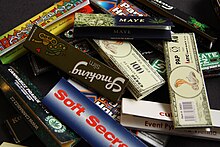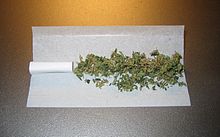Cigarette paper
Cigarette paper is the smoldering, thin, usually odorless and tasteless paper that envelops the tobacco of a cigarette . The smoldering ability is achieved through special impregnations.
In industrially manufactured cigarettes, the cigarette paper is an integral part of the product. For the industrial production of cigarettes, cigarette paper is cut into 19 to 27 mm wide, 6000 m long rolls ("bobbins"). In the case of self-filled cigarettes, the cigarette paper is part of the so-called tube, consisting of the paper tube and the already installed filter.
In particular, cigarette paper is understood to mean the paper which is available separately for the production of hand-rolled cigarettes. This paper is also known as leaflet or paper (s) , in Austria as root paper and in the technical field as RYO paper (roll your own).
Components and properties
The paper is usually based on cellulose, which is made from wood , hemp , rice or flax , whereby mixtures of different materials are common today. For RYO papers, flax and hemp paper traditionally have a high share, in Europe around 70 to 90% of the hemp fiber harvest is used to make pulp for cigarette papers . Overall, the importance of high-purity wood pulp is increasing.
Cigarette paper has a filler content of around 30%, almost exclusively lime ( calcium carbonate ). Other fillers common in the paper industry, such as kaolin and titanium dioxide, are not used in Europe. The high filler content is necessary to make the paper smolderable. It also improves smoothness, printability and opacity .
By adding fire salts , mostly alkali salts of organic acids ( e.g. trisodium citrate , tripotassium citrate , sodium acetate , etc.), the flammability of the paper is brought into line with that of tobacco, so that both burn off at about the same rate.
An important property of the cigarette paper is its porosity . This is given in CU ( Coresta Units = ml / cm² / min / kPa pressure difference air). Cigarettes under approx. 15 CU go out because too little oxygen can diffuse in. The smoke values of a cigarette can also be adjusted with the porosity. With a higher porosity one achieves on the one hand a dilution of the smoke with air and at the same time a certain diffusion of starting materials to and products from the smoldering fire when the cigarette is lying down. Today porosities of 50 to 4000 CU are used for "light" products, the holes being in the order of magnitude of 50 to 300 µm, and mostly produced by means of laser perforation.
Cigarette paper is much thinner (lighter per unit area) than writing paper, for example. The mass per unit area is only about 18–24 g / m².
Rolling paper for rolling cigarettes
For hand-rolled cigarettes, cigarette paper is cut into rectangular pieces of paper approx. 70 × 35 mm in size, which are called "leaves".
Type A and Type B
For cigarette papers, ISO 15592-3 differentiates between type A and type B, which differ in their fire behavior. On rolling tobacco you will sometimes find the information that certain condensate and nicotine values apply to type A or type B cigarette papers.
Type A cigarette paper contains little fillers (lime) and no fire salts. It burns down quicker, and if you don't pull on the cigarette regularly, the embers will go out. The paper is lighter, thinner and more breathable than the type B. With cigarette paper type A you achieve lower condensate and nicotine values. Type A supposedly tastes "rounder" than type B.
Type B cigarette paper contains fire salts and more fillers. It burns longer and more evenly. Because it has more mass, it is also likely to produce a greater amount of carcinogenic soot. Type B supposedly tastes "hotter" than type A.
Gumming
The cigarette paper is on one side, along one long side, usually provided with an adhesive surface (often gum arabic or dextrin ) ("gummed") which is only activated when it is wetted with water or water-containing liquids such as saliva . With some (B) papers, in order not to wipe off an extremely thin layer of adhesive, the damp tongue should be passed over the non-rubberized underside.
The turning of the paper begins with the other long side, which is opposite the gummed side. On this side, the corners of some cigarette papers are rounded ( cut corners , literally "cut corners"). This detail makes it easier to shape the paper tube.
There is also cigarette paper that is so thin that there is no need for gumming. The "adhesive edge" is created by simply tearing off one long side of the paper: When this tear edge is wetted with saliva, the fibers swell, and when it is brought together with dry areas of the paper, the tear edge dries immediately, so that the fibers at the tear edge are attached to the "Lay" paper so that this connection remains permanent. This idea comes from the time when parts of the Middle East were under French protectorate and cigarette paper factories were established there which, from today's perspective, used ancient technologies.
packaging
The individual leaves are available in cardboard boxes, which are called booklets, folded lengthways roughly in the middle. Common pack sizes are 50 or 100 pieces.
The booklets have a cut-out in the middle from which the first paper can already be seen. One half of a paper lies in the fold (i.e. inside) of the next paper, so that when you pull out a leaf you pull out the beginning of the next to make it easier to remove (as is the case with tissue dispensers, for example).
Special papers
"Longpaper" (English long : lang, English paper : paper ) is cigarette paper that is longer and often wider than ordinary cigarette paper. It is popularly used for rolling joints . Long papers are available in many places in Germany: apart from in head shops they can also be found in the assortment of kiosks, petrol stations etc. Also available are “endless” long papers, rolled up in a small cardboard box (such as household foil).
Transparent cigarette paper is offered in Germany. It consists of a special type of cellulose ( cell glass ) and does not require any gumming because it swells itself when it is moistened and becomes sticky to itself.
Cigarette papers with flavorings (for example fruit, cognac or mint chocolate flavor) and printed cigarette papers should also be mentioned.
Precautions for cigarette paper in the EU
In order to reduce the risk of ignition of flammable surfaces on which unattended smoldering cigarettes can fall, and thus the risk of fire accidents, the European Union introduced a new safety barrier for cigarette paper in the EU on November 17, 2011, which is in DIN EN 16156 is described. Since November 17, 2011, only cigarettes manufactured according to the RIP process may be sold in the EU (RIP = reduced ignition propensity , German for “reduced ignition propensity”). National authorities are responsible for enforcing the new regulation.
The RIP process ensures that a cigarette goes out when it comes to rest on a surface. This property is tested using the test procedure described in ISO 12863: 2010. At least 75% of all cigarettes placed on ten layers of filter paper must go out here. Extinguishing the cigarette because it is not actively being drawn is not desirable per se, but results from the fluctuations in production in the manufacture of the papers, the climatic conditions in which the cigarette is smoked and the cigarette design.
One method for producing RIP cigarettes is the use of cigarette paper in which the diffusion of oxygen through the paper is reduced in at least two places. This can be done by applying strips of finely ground cellulose or by printing film-forming polysaccharides. As a result, a cigarette goes out if it comes to rest on a surface as soon as the burning tobacco hits one of these zones.
More papers for cigarettes
In addition to cigarette paper (wrapping paper for tobacco), two other types of paper are used in cigarette production: filter wrapping paper and mouthpiece paper (see papers for cigarettes ).
"Cigarette paper" for postage stamps
In philately , "cigarette paper" describes an extraordinarily thin paper that does not necessarily have to come from cigarette production.
Individual evidence
- ↑ Jürgen Blechschmidt (Ed.): Taschenbuch der Papiertechnik , Fachbuchverlag Leipzig in Carl Hanser Verlag, 2nd, updated edition 2013, p. 51.
- ^ Verband Deutscher Papierfabriken eV: Paper ABC (PDF), as of 2015, keyword cigarette paper .
- ↑ a b Type A cigarette paper - product information helpster.de
- ↑ EU fire protection regulation for cigarettes euractiv.de, November 14, 2011.





